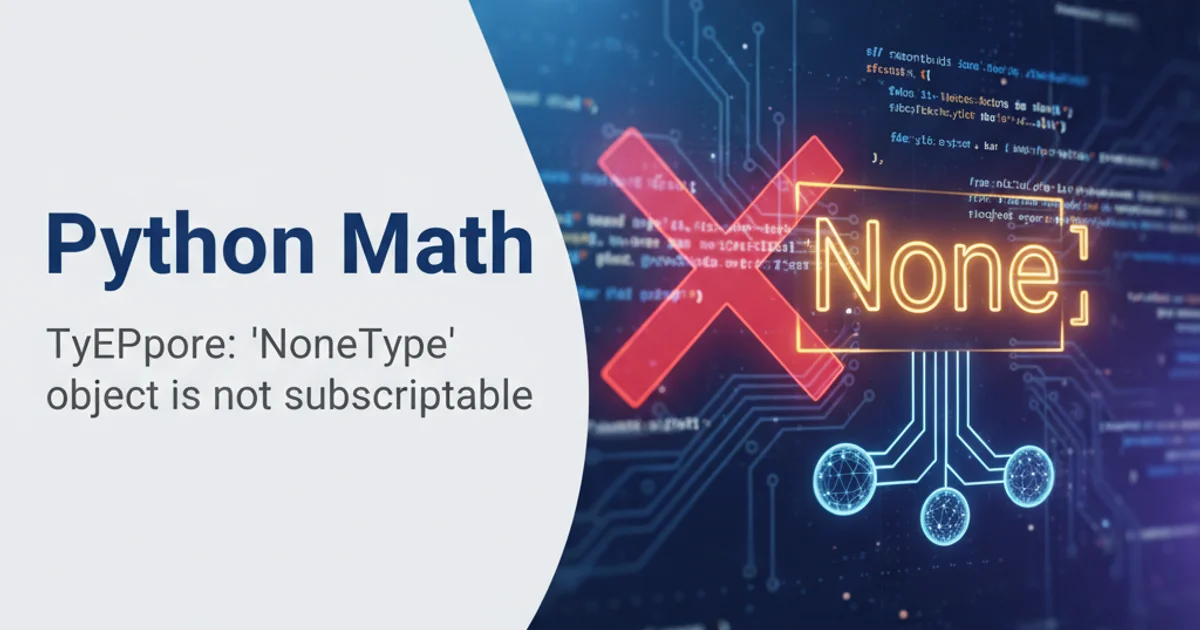Python Math - TypeError: 'NoneType' object is not subscriptable
Categories:
Python Math: Understanding and Resolving 'NoneType' object is not subscriptable

Dive into the common Python error 'NoneType' object is not subscriptable, especially in mathematical contexts, and learn effective debugging and prevention strategies.
The TypeError: 'NoneType' object is not subscriptable is a common Python error that often puzzles beginners and experienced developers alike. It occurs when you try to access an element of an object using square brackets (like my_list[0] or my_dict['key']), but the object you're trying to subscript is None. In mathematical operations or data processing, this usually indicates that a function or operation unexpectedly returned None instead of an iterable (like a list, tuple, or dictionary) or a numerical value, and you then attempted to treat that None as if it were a collection.
What Does 'NoneType' object is not subscriptable Mean?
In Python, None is a special constant that represents the absence of a value or a null value. It's the sole instance of the NoneType class. When you see this error, it means a variable or the result of an expression that you expected to be a sequence (like a list or string) or a mapping (like a dictionary) has actually evaluated to None. Subsequently, you tried to use the subscript operator [] on this None value, which is not allowed because None has no elements to access.
flowchart TD
A[Code Execution] --> B{Function/Method Call};
B --> C{Return Value?};
C -- Yes, returns None --> D[Variable assigned None];
C -- No, returns iterable --> E[Variable assigned iterable];
D --> F{Attempt to subscript variable?};
F -- Yes --> G["TypeError: 'NoneType' object is not subscriptable"];
F -- No --> H[Code continues];
E --> I[Subscript operation successful];Flowchart illustrating how a 'NoneType' error occurs during subscripting.
Common Scenarios Leading to the Error in Math/Data Processing
This error frequently arises in mathematical or data processing contexts due to a few common pitfalls:
- Functions that don't return a value: A function that performs an operation but doesn't explicitly
returnanything will implicitly returnNone. - In-place operations: Many list methods (e.g.,
list.sort(),list.append(),list.reverse()) modify the list in-place and returnNone. If you try to assign the result of such an operation to a variable and then subscript it, you'll get this error. - Conditional logic failures: If a conditional branch that's supposed to initialize a variable or return a value is skipped, the variable might remain
None. - Incorrect API usage: Using a library function that returns
Noneunder certain conditions (e.g., if a search yields no results) and not handling thatNonecase.
# Scenario 1: Function implicitly returns None
def calculate_sum(a, b):
total = a + b
# Missing 'return total'
result = calculate_sum(5, 3)
# print(result[0]) # This would raise TypeError: 'NoneType' object is not subscriptable
# Scenario 2: In-place list sorting
my_numbers = [3, 1, 4, 1, 5, 9]
sorted_numbers = my_numbers.sort() # .sort() sorts in-place and returns None
# print(sorted_numbers[0]) # This raises TypeError: 'NoneType' object is not subscriptable
# Correct way for scenario 2:
my_numbers = [3, 1, 4, 1, 5, 9]
my_numbers.sort() # Sorts in-place
print(my_numbers[0]) # Access the sorted list directly
# Or, if you need a new sorted list:
original_numbers = [3, 1, 4, 1, 5, 9]
newly_sorted_numbers = sorted(original_numbers) # sorted() returns a new sorted list
print(newly_sorted_numbers[0])
Examples of common scenarios leading to 'NoneType' subscripting errors.
Debugging and Prevention Strategies
To effectively debug and prevent this error, focus on identifying where None is being introduced into your code. Here are some strategies:
1. Print and Inspect Variables
Before the line where the error occurs, print the variable that's causing the issue. This will immediately show you if it's None.
2. Check Function Return Values
If the variable is the result of a function call, verify that the function is indeed returning the expected data type and not None. Ensure all code paths within your function explicitly return a value.
3. Understand In-Place Operations
Be mindful of methods that modify objects in-place (like list.sort(), list.append(), list.reverse(), dict.update()). These methods return None. If you need a new object, use functions like sorted() for lists or create a copy before modifying.
4. Use Debuggers
A debugger (like pdb in Python or IDE debuggers) allows you to step through your code line by line and inspect variable states, making it easier to pinpoint where None originates.
5. Implement Robust Error Handling
When dealing with external data, user input, or functions that might legitimately return None (e.g., dict.get() with a missing key), explicitly check for None before attempting to subscript. Use if variable is not None: or provide default values.
# Example of robust error handling
def get_data_from_source(key):
# Simulate a function that might return None
data_store = {'valid_key': [10, 20, 30]}
return data_store.get(key) # .get() returns None if key not found
result = get_data_from_source('valid_key')
if result is not None:
print(f"First element: {result[0]}")
else:
print("Data not found or returned None.")
result_none = get_data_from_source('invalid_key')
if result_none is not None:
print(f"First element: {result_none[0]}")
else:
print("Data not found or returned None.")
Using if result is not None: to prevent the error.
list.sort() modifies the list in-place and returns None. If you need a new sorted list, use the built-in sorted() function, which returns a new sorted list and leaves the original untouched.